Facilitating Physical Activity through On-Site Quantified-Self Data Sharing
Abstract
1. Introduction
2. Related Works
2.1. Quantified-Self Data in Social Scenarios
2.2. Digitally Enhanced On-Site Social Interactions
3. Design and Simulation System
3.1. Design of SocialBike
3.2. Cycling Simulation System
3.2.1. Simulating Ordinary Cycling Experience
3.2.2. Simulating the Concept of Social Bike
3.2.3. Record Experimental Data
4. Evaluation
4.1. Subjects
4.2. Independent Variable
4.3. Measurements
4.3.1. Quantitative Measurements
4.3.2. Qualitative Measurement
4.4. Setup
4.5. Procedure
5. Results
5.1. Quantitative Results
5.1.1. Results of the Intrinsic Motivation Inventory
5.1.2. Results of Users’ Cycling Behavior
5.2. Qualitative Results
5.2.1. Preference for Front Display Types
5.2.2. Source of Motivation
5.2.3. Influence of Performance Gap
5.2.4. Influence of Use Scenarios
5.2.5. Influence on Social Behavior
5.2.6. On-Site Sharing versus Off-Site Sharing
5.2.7. Data Visualization
5.2.8. Rear Display and Privacy Concerns
5.2.9. Opportunity for Further Development
6. Discussion
6.1. Motivation and Competition
6.2. Impact of Scenarios
6.3. Digitally Enhanced On-Site Interaction
6.4. Privacy and User Autonomy
7. Conclusions
Author Contributions
Funding
Conflicts of Interest
References
- Guerrero, L.K.; Floyd, K. Nonverbal Communication in Close Relationships; Routledge: Abingdon, UK, 2016. [Google Scholar]
- Hall, J.A.; Horgan, T.G.; Murphy, N.A. Nonverbal communication. Annu. Rev. Psychol. 2019, 70, 271–294. [Google Scholar] [CrossRef] [PubMed]
- Ivanov, A.; Sharman, R.; Rao, R.H. Exploring factors impacting sharing health-tracking records. Health Policy Technol. 2015, 4, 263–276. [Google Scholar] [CrossRef]
- Epstein, D.A.; Jacobson, B.H.; Bales, E.; McDonald, D.W.; Munson, S.A. From nobody cares to way to go: A Design Framework for Social Sharing in Personal Informatics. In Proceedings of the 18th ACM Conference on Computer Supported Cooperative Work & Social Computing, Vancouver, BC, Canada, 1–3 March 2015; pp. 1622–1636. [Google Scholar]
- Colley, A.; Pfleging, B.; Alt, F.; Häkkilä, J. Exploring public wearable display of wellness tracker data. Int. J. Hum. Comput. Stud. 2020, 138, 102408. [Google Scholar] [CrossRef]
- Hassib, M.; Buschek, D.; Wozniak, P.W.; Alt, F. HeartChat: Heart rate augmented mobile chat to support empathy and awareness. In Proceedings of the 2017 CHI Conference on Human Factors in Computing Systems, Danver, CO, USA, 6–11 May 2017; pp. 2239–2251. [Google Scholar]
- Curmi, F.; Ferrario, M.A.; Whittle, J. Biometric data sharing in the wild: Investigating the effects on online sports spectators. Int. J. Hum. Comput. Stud. 2017, 105, 56–67. [Google Scholar] [CrossRef]
- Sonne, T.; Jensen, M.M. Race By Hearts. In International Conference on Entertainment Computing; Springer: Berlin, Germany/Heidelberg, 2014; pp. 125–132. [Google Scholar]
- Walmink, W.; Wilde, D.; Mueller, F.F. Displaying heart rate data on a bicycle helmet to support social exertion experiences. In Proceedings of the 8th International Conference on Tangible, Embedded and Embodied Interaction, Munich, Germany, 16–19 February 2014; pp. 97–104. [Google Scholar]
- Mauriello, M.; Gubbels, M.; Froehlich, J.E. Social fabric fitness: The design and evaluation of wearable E-textile displays to support group running. In Proceedings of the SIGCHI Conference on Human Factors in Computing Systems, Toronto, Canada, 26 April–1 May 2014; pp. 2833–2842. [Google Scholar]
- Epp, F.A. Expressive Wearables: Practices-Oriented Codesign for New Forms of Social Mobile Technology. Int. J. Mob. Hum. Comput. Int. 2019, 11, 1–15. [Google Scholar] [CrossRef]
- Dierk, C.; Nicholas, M.J.P.; Paulos, E. AlterWear: Battery-free wearable displays for opportunistic interactions. In Proceedings of the 2018 CHI Conference on Human Factors in Computing Systems, Montréal, QC, Canada, 21–26 April 2018; pp. 1–11. [Google Scholar]
- Walmink, W.; Chatham, A.; Mueller, F. Interaction opportunities around helmet design. In Proceedings of the CHI’14 Extended Abstracts on Human Factors in Computing Systems, Toronto, ON, Canada, 26 April–1 May 2014; pp. 367–370. [Google Scholar]
- Ikeda, K.; Koizumi, N.; Naemura, T. FunCushion: Fabricating functional cushion interfaces with fluorescent-pattern displays. In International Conference on Advances in Computer Entertainment; Springer: Cham, Switzerland, 2017; pp. 470–487. [Google Scholar]
- Kan, V.; Fujii, K.; Amores, J.; Jin, Z.L.C.; Maes, P.; Ishii, H. Social textiles: Social affordances and icebreaking interactions through wearable social messaging. In Proceedings of the Ninth International Conference on Tangible, Embedded, and Embodied Interaction, ACM, Standford, CA, USA, 15–19 January 2015; pp. 619–624. [Google Scholar]
- Genç, Ç.; Erkaya, M.; Balci, F.; Özcan, O. Exploring Dynamic Expressions on Soft Wearables for Physical Exercises. In Proceedings of the DIS 2018 Companion Publication of the 2018 Designing Interactive Systems Conference, Hong Kong, China, 9–13 June 2018; pp. 147–152. [Google Scholar]
- Liu, X.; Vega, K.; Qian, J.; Paradiso, J.; Maes, P. Fluxa: Body movements as a social display. In Proceedings of the 29th Annual Symposium on User Interface Software and Technology, Tokyo, Japan, 16–19 October 2016; pp. 155–157. [Google Scholar]
- Harjuniemi, E.; Colley, A.; Rytilahti, P.; Li, H.; Forest, J.; Häkkilä, J. Idle stripes shirt: Ambient wearable display for activity tracking. In Proceedings of the 2018 ACM International Symposium on Wearable Computers, Singapore, 8–12 October 2018; pp. 254–259. [Google Scholar]
- Yang, N.; van Hout, G.; Feijs, L.M.; Chen, W.; Hu, J. i-Ribbon: Social Expression Through Wearables to Support Weight-Loss Efforts. In Intelligent Environments; IOS Press: Amsterdam, The Netherlands, 2016; pp. 524–533. [Google Scholar]
- Yang, N.; van Hout, G.; Feijs, L.; Chen, W.; Hu, J. Eliciting values through wearable expression in weight loss. In Proceedings of the 19th International Conference on Human-Computer Interaction with Mobile Devices and Services, Vienna, Austria, 4–7 September 2017; pp. 1–6. [Google Scholar]
- Pearson, J.; Robinson, S.; Jones, M. It’s About Time: Smartwatches as public displays. In Proceedings of the 33rd Annual ACM Conference on Human Factors in Computing Systems, Seoul, Korea, 18–23 April 2015; pp. 1257–1266. [Google Scholar]
- Kleinman, L.; Hirsch, T.; Yurdana, M. Exploring mobile devices as personal public displays. In Proceedings of the 17th International Conference on Human-Computer Interaction with Mobile Devices and Services, Copenhagen, Denmark, 24–27 August 2015; pp. 233–243. [Google Scholar]
- Jarusriboonchai, P.; Li, H.; Harjuniemi, E.; Müller, H.; Häkkilä, J. Always with Me: Exploring Wearable Displays as a Lightweight Intimate Communication Channel. In Proceedings of the Fourteenth International Conference on Tangible, Embedded, and Embodied Interaction, Sydney, Australia, 9–12 February 2020; pp. 771–783. [Google Scholar]
- Yang, N.; van Hout, G.; Feijs, L.; Chen, W.; Hu, J. Supporting weight loss through digitally-augmented social expression. In International Conference on Human-Computer Interaction; Springer: Cham, Switzerland, 2019; pp. 459–470. [Google Scholar]
- Johnstone, A.M.; Murison, S.D.; Duncan, J.S.; Rance, K.A.; Speakman, J.R. Factors influencing variation in basal metabolic rate include fat-free mass, fat mass, age, and circulating thyroxine but not sex, circulating leptin, or triiodothyronine. Am. J. Clin. Nutr. 2005, 82, 941–948. [Google Scholar] [CrossRef] [PubMed]
- Ainsworth, B.E.; Haskell, W.L.; Herrmann, S.D.; Meckes, N.; Bassett, D.R., Jr.; Tudor-Locke, C.; Greer, J.L.; Vezina, J.; Whitt-Glover, M.C.; Leon, A.S. Compendium of Physical Activities: A second update of codes and MET values. Med. Sci. Sports Exerc. 2011, 43, 1575–1581. [Google Scholar] [CrossRef] [PubMed]
- Yang, N.; van Hout, G.; Feijs, L.; Chen, W.; Hu, J. Simulating social cycling experience in design research. In International Conference on Human Systems Engineering and Design: Future Trends and Applications; Springer: Cham, Switzerland, 2019; pp. 379–384. [Google Scholar]
- Yang, N.; van Hout, G.; Feijs, L.; Chen, W.; Hu, J. SocialBike: Quantified-Self Data as Social Cue in Physical Activity. In EAI International Conference on IoT Technologies for HealthCare; Springer: Cham Switzerland, 2019; pp. 92–107. [Google Scholar]
- Yang, N.; van Hout, G.; Feijs, L.; Chen, W.; Hu, J. Enhancing Intrinsic Motivation in Physical Activity through Quantified-self Data Sharing. EAI Endorsed Trans. Pervasive health Technol. 2020, 6, 1–12. [Google Scholar] [CrossRef]
- McAuley, E.; Duncan, T.; Tammen, V.V. Psychometric properties of the Intrinsic Motivation Inventory in a competitive sport setting: A confirmatory factor analysis. Res. Q. Exerc. Sport 1989, 60, 48–58. [Google Scholar] [CrossRef] [PubMed]
- Braun, V.; Clarke, V. Using thematic analysis in psychology. Qual. Res. Psychol. 2006, 3, 77–101. [Google Scholar] [CrossRef]
- Clarke, V.; Braun, V.; Hayfield, N. Thematic Analysis. Qualitative Psychology: A Practical Guide to Research Methods; SAGE Publications: London, UK, 2015; pp. 222–248. [Google Scholar]
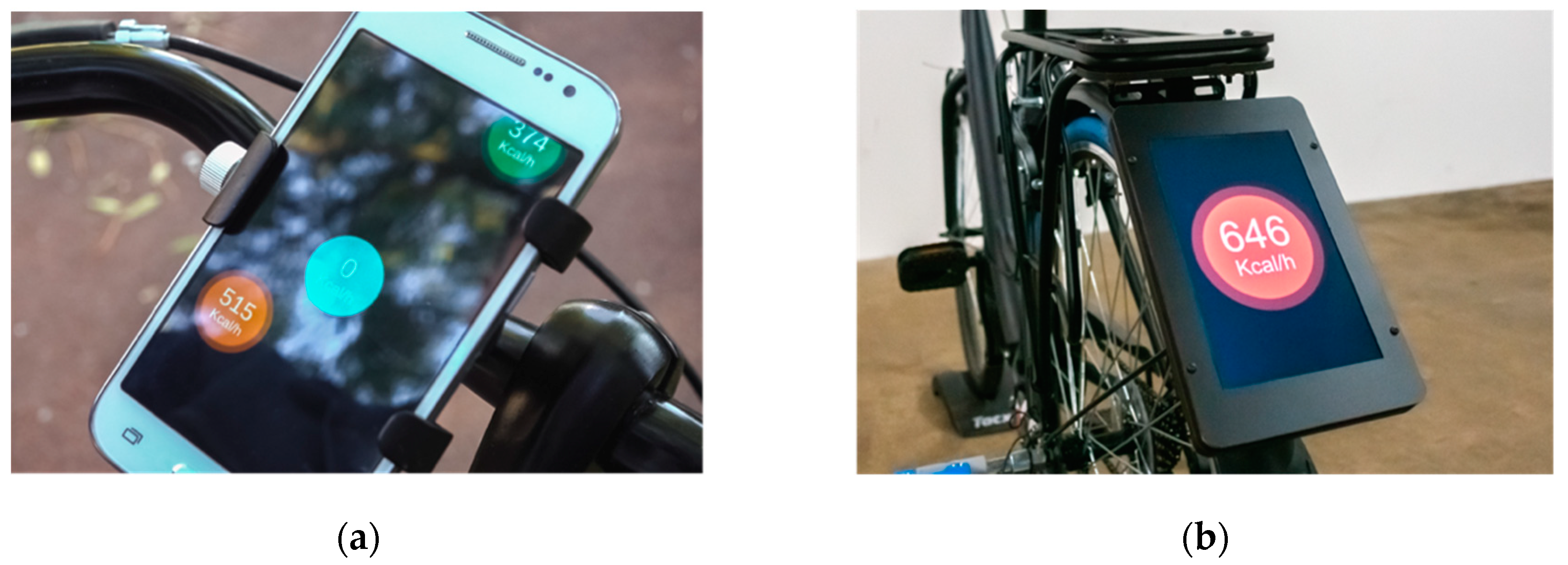

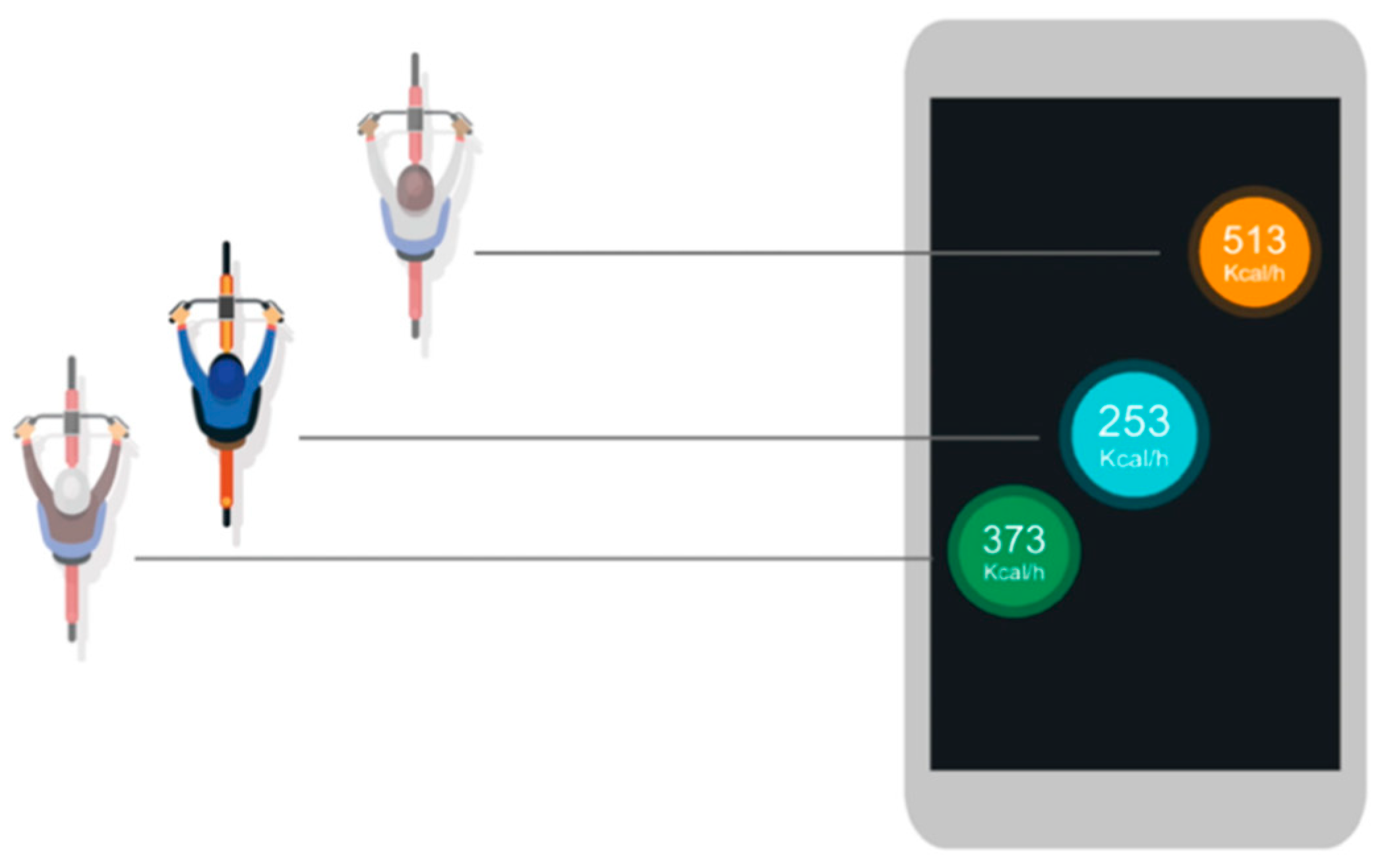
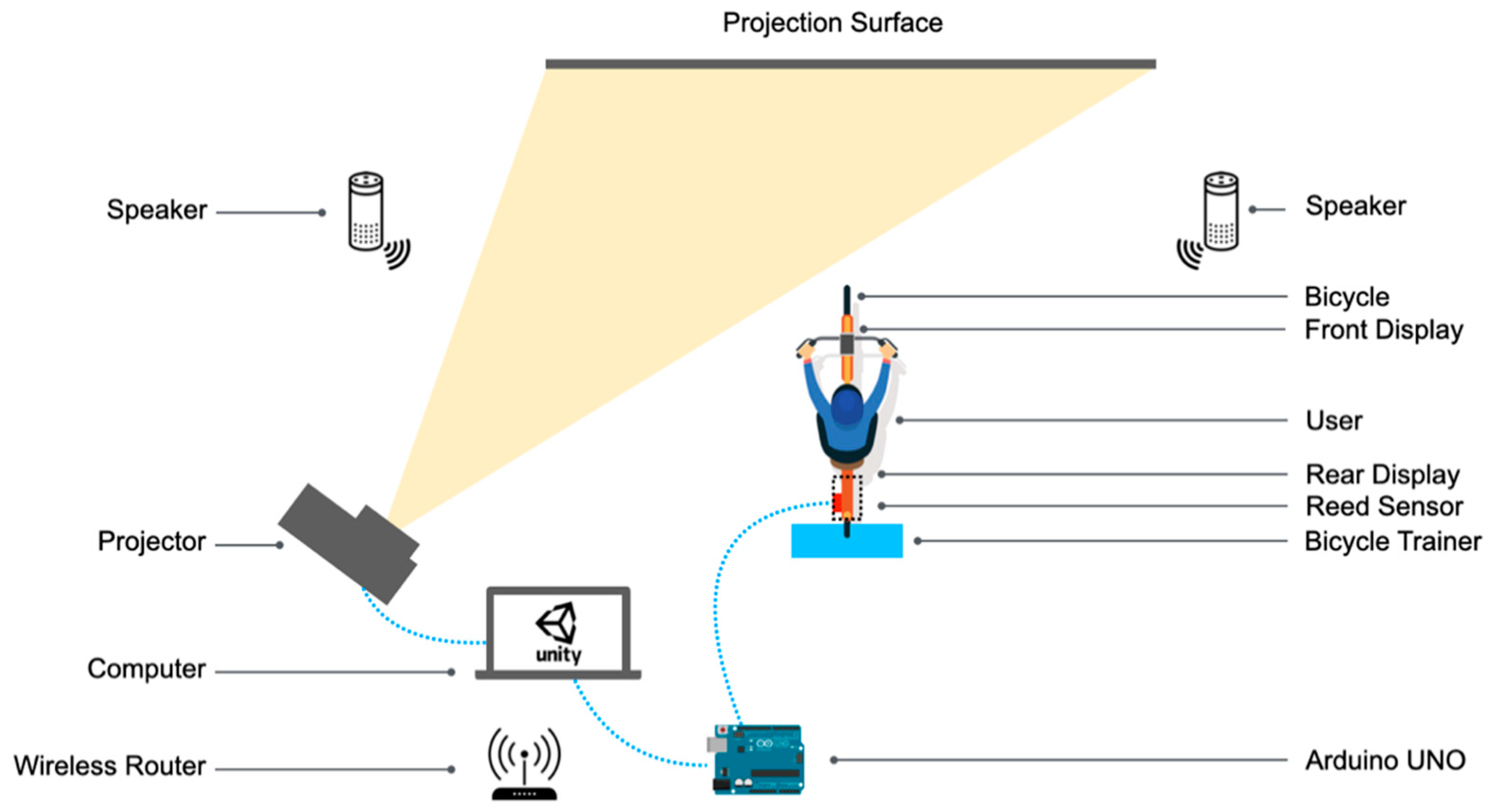

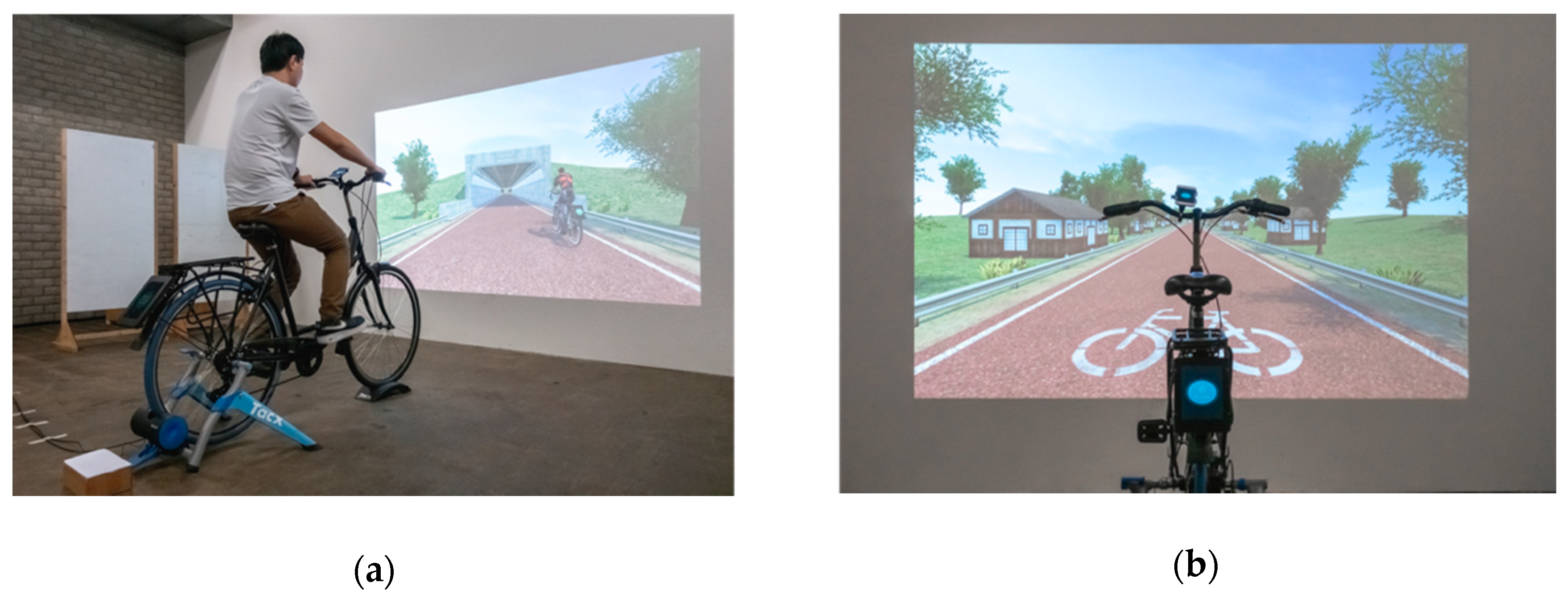
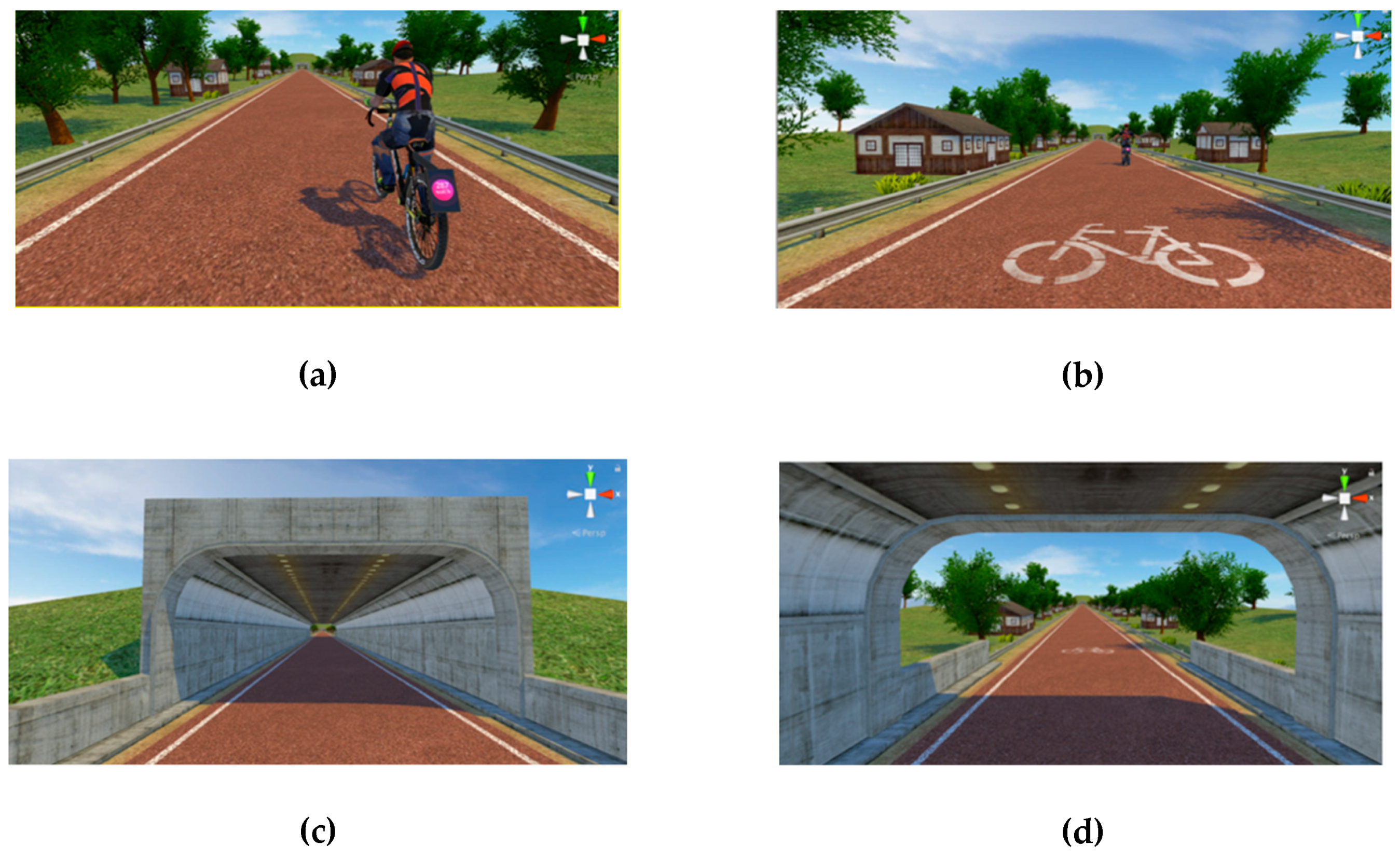
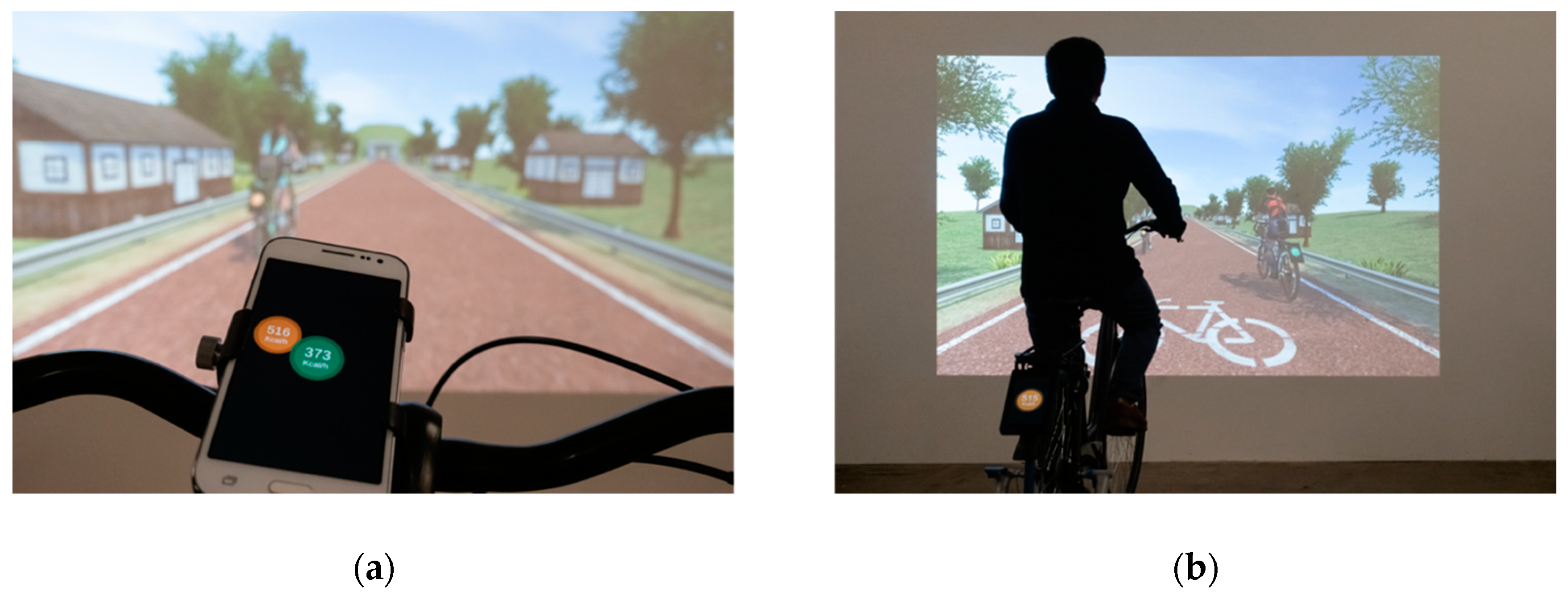


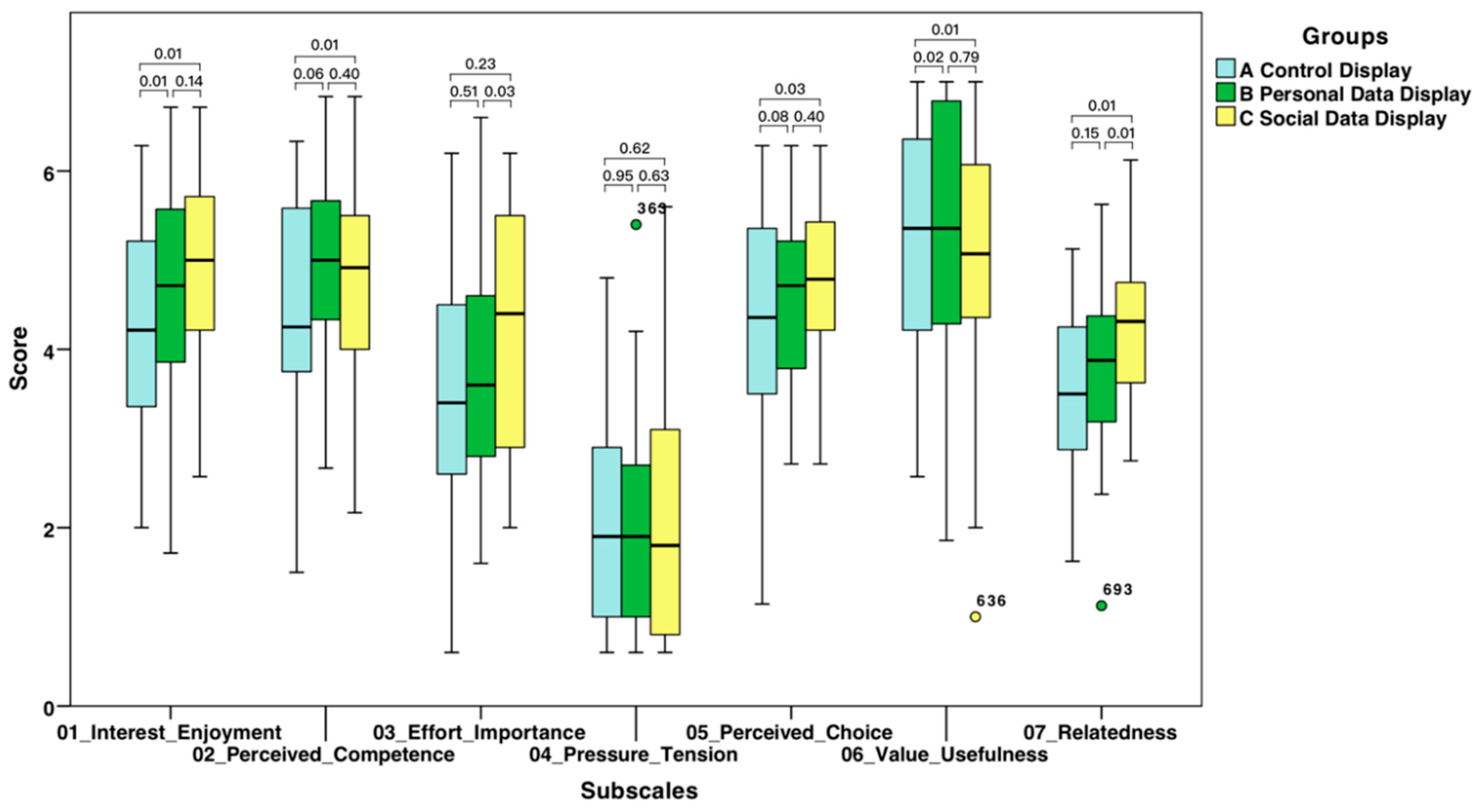
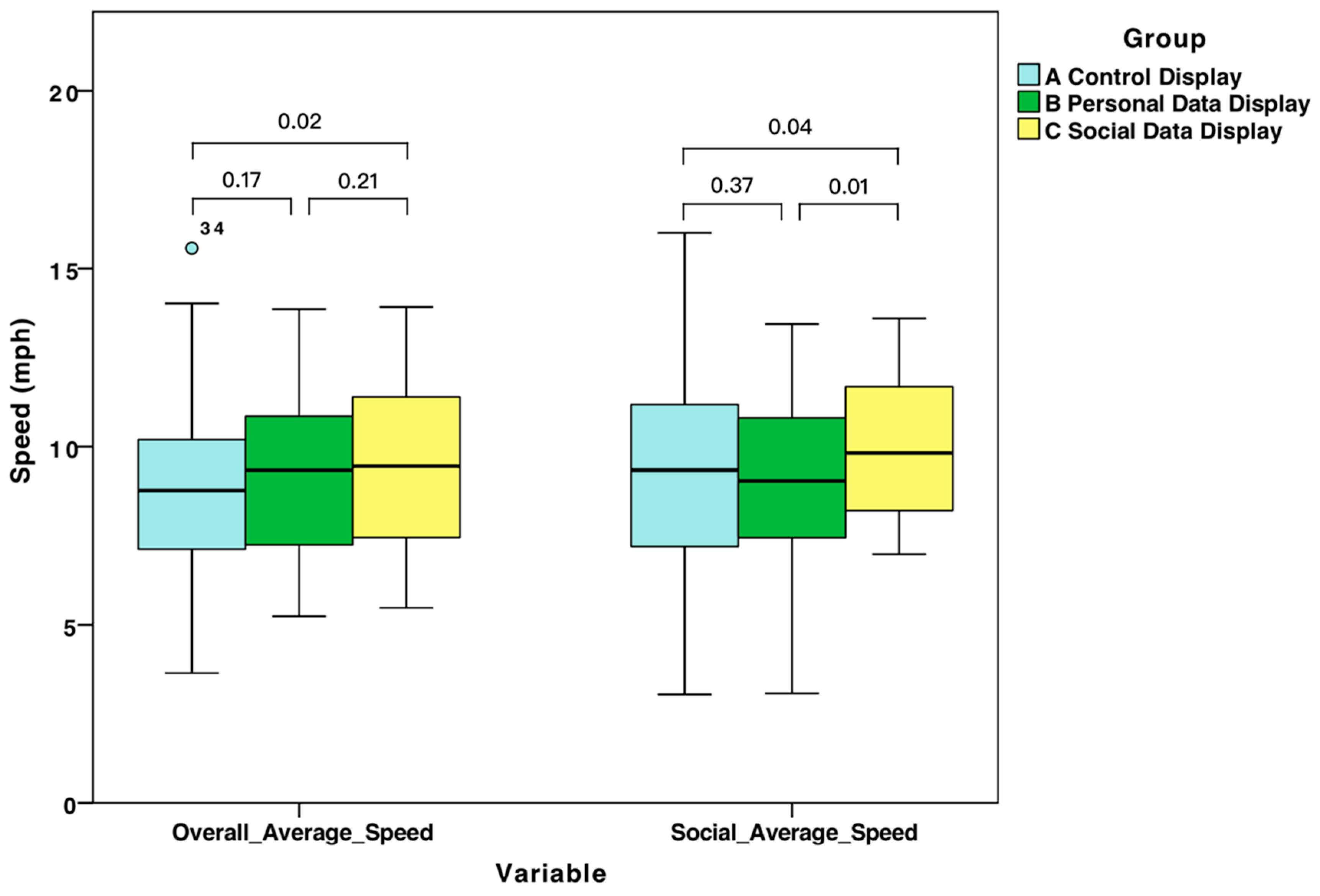
| Groups Comparison | Subscales | Mean Differences | Standard Deviation Differences | p-Value |
|---|---|---|---|---|
| B-A | Interest/Enjoyment | 0.4087302 | −0.9334427 | 0.0127 |
| Perceived Competence | 0.3611111 | −1.1244046 | 0.0621 | |
| Effort/Importance | 0.1944444 | −1.7840475 | 0.5174 | |
| Pressure/Tension | 0.0111111 | −1.0838497 | 0.9513 | |
| Perceived Choice | 0.2341270 | −0.7803362 | 0.0805 | |
| Value/Usefulness | 0.2817460 | −0.6713514 | 0.0165 | |
| Relatedness | 0.2534722 | −1.0396111 | 0.1524 | |
| C-A | Interest/Enjoyment | 0.6111111 | −1.1365187 | 0.0027 |
| Perceived Competence | 0.2361111 | −1.1807820 | 0.2383 | |
| Effort/Importance | 0.7388889 | −1.3821883 | 0.0029 | |
| Pressure/Tension | 0.1055556 | −1.2508156 | 0.6158 | |
| Perceived Choice | 0.3492063 | −0.9057281 | 0.0267 | |
| Value/Usefulness | 0.3095238 | −0.6528699 | 0.0074 | |
| Relatedness | 0.7118056 | −0.9305430 | 0.0001 | |
| C-B | Interest/Enjoyment | 0.2023810 | −0.8040531 | 0.1400 |
| Perceived Competence | −0.1250000 | −0.8974169 | 0.4090 | |
| Effort/Importance | 0.5444444 | −1.4693914 | 0.0328 | |
| Pressure/Tension | 0.0944444 | −1.1870599 | 0.6361 | |
| Perceived Choice | 0.1150794 | −0.8051000 | 0.3969 | |
| Value/Usefulness | 0.0277778 | −0.6087979 | 0.7859 | |
| Relatedness | 0.4583333 | −0.6661456 | 0.0002 |
| Groups Comparison | Variables | Mean Differences | Standard Deviation Differences | p-Value |
|---|---|---|---|---|
| B-A | Overall Average Speed | 0.4074537 | −1.7481947 | 0.1708 |
| Social Average Speed | −0.2735097 | −1.8170849 | 0.3726 | |
| C-A | Overall Average Speed | 0.6917943 | 1.6785748 | 0.0184 |
| Social Average Speed | 0.6964290 | −1.9919094 | 0.0432 | |
| C-B | Overall Average Speed | 0.2843405 | −1.3319899 | 0.2087 |
| Social Average Speed | 0.9699387 | −1.7587369 | 0.0022 |
| Themes | Codes (Number of Participants) | Exemplar Quotes |
|---|---|---|
| Preference for Front Display | Prefer Display C (29) | “I can already tell who was going to overtake me, and how fast he was riding.” |
| Prefer Display B (7) | “I only care about how many calories I burned, I don’t care about other people’s data.” | |
| Display C brought too much competition (2) | “It (Display C) becomes a competition for me. I put a lot of effort into this part. I see a girl passing by me. I tried to chase her but can’t make it. So, I kind of disappointed myself.” | |
| Source of Motivation | Competitive (22) | “I feel more competent when doing this thing because I can see others’ data.” |
| Compare to Regular Cycling Behavior (3) | “Without this app, I would not compare with others… Now the numbers are shown. It motivated me to make some changes in riding.” | |
| Curiosity (5) | “Their data made me curious. I know the person in front of me was fast. I want to see how fast she is… I think curiosity gives me more motivation than performance.” | |
| Influence of Performance Gap | Performance Gap (12) | “I tried to catch up with her, but later I found that she was too fast, so I slowed down, and ride with the slow one.” |
| Health Risk (2) | “If my heart situation is not as good as her, it might be risky for me… I tried, but I start to get tired, so I stop chasing her.” | |
| Influence of Use Scenarios | Use Scenarios (5) | “It depends. If I have a class, I’ll want to keep it a little bit slower. Not be drowned in sweat… If I have a more suitable clothes, I will perform better. Sometimes I really want to catch up with the fast rider.” |
| Commuting Purpose (2) | “If I have a clear purpose, it will have less impact on me.” | |
| Traffic Condition (1) | “If the traffic was too busy, I might worry about safety. It would be better if I was riding in the countryside.” | |
| Influence on Social Behavior | Trigger for Social Interaction with Strangers (6) | “This is an opportunity to open a conversation. It could be embarrassing to talk with strangers, but if you are using the same system at the same time, it is easier to start.” |
| Stranger Met Multiple Times (2) | “I want to know how many times I have met him. If I meet him several times, I will be more familiar with him and more willing to interact with him.” | |
| Competitive Relationship with Acquaintances (2) | “Riding with friends will be more competitive. They will always want to overtake you. The competition is more continuous.” | |
| Supportive Relationship with Acquaintances (5) | “If I am faster, my data will help him to keep along with me. If he is faster, his data will help me to keep along with him.” | |
| On-site Sharing versus Off-site Sharing | Saw Health-related Data Sharing on SNS (Social Networking Service) (23) | “My friend and cousin are doing this.” |
| Not Influenced by Others’ Data Sharing on SNS (20) | “I saw this and knew that he did some exercise, but I didn’t care about the details, I wouldn’t compare myself with them.” | |
| Enjoy Others’ Data Sharing on SNS (3) | “I feel happy for them. I feel motivated to do that (marathon), but I have never done that.” | |
| Improve Motivation for Exercise (7) | “This one is encouraging me more than just posting it on Facebook afterwards. It encourages me to use the bike to work out.” | |
| More Connected to Other Cyclists (5) | “The feeling of the moment can’t be taken home… because you are doing the same thing with me, so I pay more attention to the data you shared. If you are at home, our connection is weak.” | |
| Concern about Real-time Data (3) | “If I have been riding for a long time, I feel tired, and then I slow down, but the person just saw me might think I’m not riding hard.” | |
| Data Visualization | Attract by Color Change (28) | “Color is more intuitive. If there are many people on the road, you can tell who is with me based on the color. I will ride closer to them if their color is similar to mine.” |
| Attract by Numbers (8) | “I focused on numbers first, it was something that is really controlled by my speed. Color can be a side message.” | |
| The Breathing Animation is too Subtle (11) | “I can see the change in color even if I am not staring at the screen. For the animation, I need to look at it for two or three seconds (P25).” | |
| Rear Display and Privacy Concerns | Interested in Others’ Rear Display (5) | “It attracts me to go closer to other people and interact with them.” |
| No Privacy Concern about Rear Display (29) | “Because I can also see other people’s data, everyone is sharing… It is not a shameful number.” | |
| Only Share Real-time Data (5) | “I want to know more about my own riding information, such as distance… But I only want to share the real-time data. Historical data has some privacy issues.“ | |
| Turn off Rear Display (2) | “Maybe I will turn it off; I don’t want to be trackable.” | |
| Opportunity for further Development | Presence of Cyclists’ side the Screen (3) | “When they go beyond the screen, I can’t see them anymore. I hope there is still some information, like some dots on the edge of the screen (P4).” |
| More Social-related Visual Effects (2) | “You can add more animation effects to make the two circles interact with each other.” | |
| Semantics of Colors (2) | “The red and yellow colors are similar to traffic lights. This may cause misunderstandings.” | |
| Expand Applications Scenarios (3) | “I can play games with this circle, like catching a Pokémon.” |
© 2020 by the authors. Licensee MDPI, Basel, Switzerland. This article is an open access article distributed under the terms and conditions of the Creative Commons Attribution (CC BY) license (http://creativecommons.org/licenses/by/4.0/).
Share and Cite
Yang, N.; van Hout, G.; Feijs, L.; Chen, W.; Hu, J. Facilitating Physical Activity through On-Site Quantified-Self Data Sharing. Sustainability 2020, 12, 4904. https://doi.org/10.3390/su12124904
Yang N, van Hout G, Feijs L, Chen W, Hu J. Facilitating Physical Activity through On-Site Quantified-Self Data Sharing. Sustainability. 2020; 12(12):4904. https://doi.org/10.3390/su12124904
Chicago/Turabian StyleYang, Nan, Gerbrand van Hout, Loe Feijs, Wei Chen, and Jun Hu. 2020. "Facilitating Physical Activity through On-Site Quantified-Self Data Sharing" Sustainability 12, no. 12: 4904. https://doi.org/10.3390/su12124904
APA StyleYang, N., van Hout, G., Feijs, L., Chen, W., & Hu, J. (2020). Facilitating Physical Activity through On-Site Quantified-Self Data Sharing. Sustainability, 12(12), 4904. https://doi.org/10.3390/su12124904






